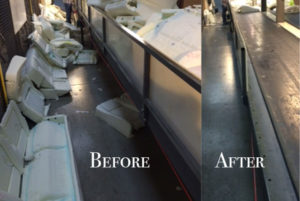Consulting Technical Service Visit
A major seating supplier to a Global OEM requested a Technical Service visit for support to reduce high scrap and repair rates and other foam related defects on their Race Track ( RT ) production line. The RT line has XX* carriers with up to three seating tools on each individual carrier. The customer uses X* in house blended polyol blends and XXXX* isocyanate.
The RT line uses two Robots to dispense the mixed liquid PU chemicals into the tools. The start of the pour to lid close time is approximately XX* sec. The foam defects witnessed during the visit included three different types of air traps along with collapse and pressure relief voids. The plant has excellent XXXX* monitoring of the pour pattern processes and does an excellent job of root cause analysis to adjust pour patterns quickly to improve the process and minimize pour pattern related foam defects.
Consulting Technical Service Timeline
We were given one week, Monday through Friday, to conduct our technical analysis.
We first observed the first and second shifts on Monday to observe how they were utilized to better understand the bulk storage, polyol blending and chemical storage in the plant. We then moved into the RT line and spent the remainder of the day working on identification & prioritization of the foam defects common on the production line. Here we took samples of each type of foam related to a defect and year to date data which greatly expedited the root cause analysis / prioritization on the RT line.
Tuesday through Thursday was spent doing Root Cause analysis and Countermeasure implementation on the RT line to reduce scrap and repair rates to an acceptable level.
Friday was then used to confirm that the countermeasures were working and for a presentation by the team documenting the results of the work completed this week.
Root Cause Analysis – Countermeasures
The bulk storage / blending areas had only minor issues and were detailed in the full report. The order of addition was changed slightly for several of the polyol blends. It was recommended that these changes should be monitored over the next few months to observe for any negative impact.
Key mechanical issues were identified Monday on the RT line. Several of these issues were easily corrected the same day however some required new parts to be ordered and installed. Installation will require a weekend of down time to implement these on the RT line. These modifications should further reduce the overall scrap and repair rates for the process engineers on the RT line.
Optimization of the pour patterns was the major area of focus over the week and eliminated most of the different air trap voids. The majority of collapse and pressure relief voids also required pour pattern changes in conjunction with improved sealing and venting of the tools to be successful.
Finally, training of the process engineers was required to quickly identify the type of foam defect and implement countermeasures that could further reduce scrap and repair rates on the RT line.
A full detailed report was provided to the customer once final analysis and presentation of findings was complete.
*Some information has been removed to protect the intellectual property of our customer.
